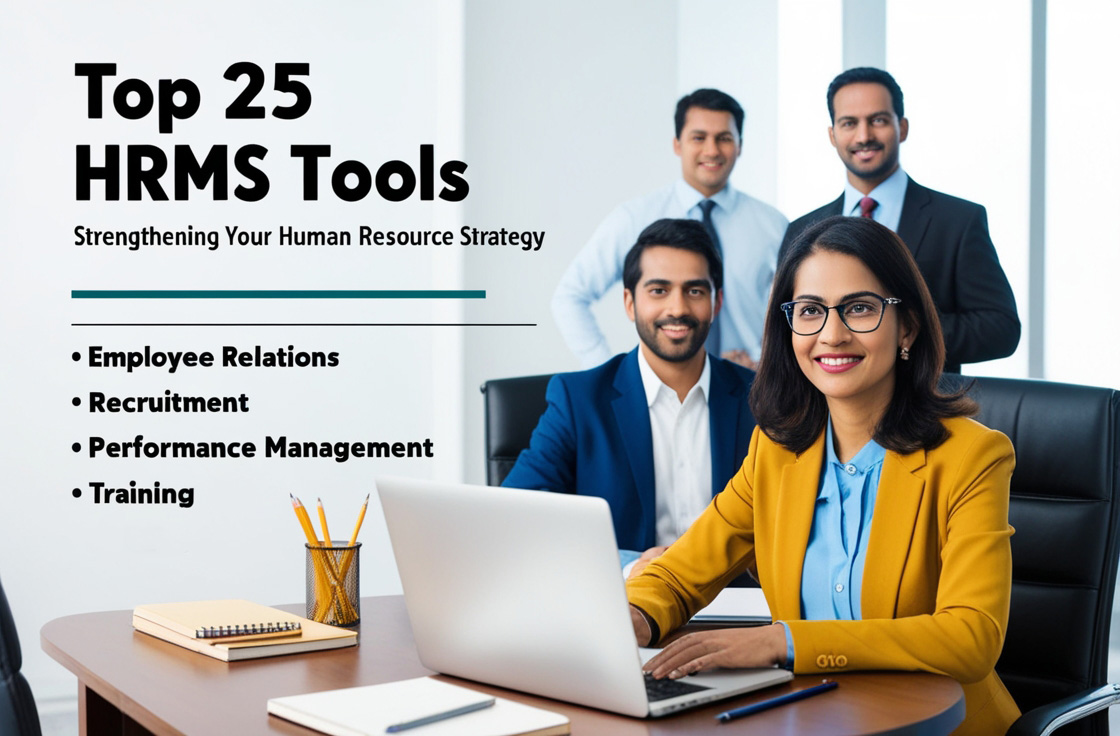Introduction
Human Resource Management Systems (HRMS) is becoming more hectic daily in terms of manual handling. However, as technology is emerging in stages, so HRMS continues to evolve with the assistance of innovative and comprehensive tools that manage your workforce smoothly.
Regardless of its AI-driven recruitment or advanced analytics management performance, HRMS solutions are indispensable for businesses that are looking to streamline their HR operations. Plus, they are seeking to improve their employee engagement process.
Therefore, here’s a look at the top 25 HRMS tools that can enhance your human resource strategy in 2026. But, before diving into the list of 25 top HRMS tools, let’s first analyze their requirement in the business context.
The Role of HR in Business Operations and its Handling
Human Resources (HR) is the backbone of any organization that manages all aspects related to employees. This department not only ensures fair treatment but also fosters a positive and safe workplace.
The Impact of HR on Business Operations
The importance of human resource management in ensuring smooth business operations is undeniable. When HR functions effectively, you hire the right people, maintain employee motivation, and resolve issues swiftly. This leads to enhanced performance, reduced turnover, and significant savings in hiring and training costs.
Key Functions of HR

HR encompasses several critical functions, including:
Recruitment: Attracting and hiring top talent.
Training: Equipping employees with the necessary skills and knowledge.
Performance Management: Monitoring and facilitating employee improvement.
Employee Relations: Maintaining positive relationships and resolving conflicts.
By executing these functions well, HR helps in ensuring the strength and efficiency of the businesses for success.
The Role of HRMS Tools in Enhancing HR Strategy
If you will integrate HRMS tools and HRportal into your HR strategy then you can smoothen your management processes significantly. These systems automate routine tasks, make them more efficient, and reduce errors as well.
Key features of HRMS tools include:
Automated Payroll Processing:
Streamlines payroll calculations, ensuring timely payments.
Recruitment Management:
Simplifies job postings, application tracking, and candidate communication.
Employee Self-Service Portals:
Empower employees to manage their own information, such as leave requests and benefits.
Performance Tracking:
Facilitates continuous performance reviews and feedback.
Analytics and Reporting:
Provides data-driven insights on employee performance, engagement, and turnover rates.
By leveraging these features, businesses can focus on strategic initiatives rather than getting bogged down in administrative tasks.

Top 25 HRMS Tools for 2026
Here, let us introduce you to the top 25 HRMS tools that will not only assist you in managing the role the HR in a better way but also will automate the entire process.

1. BambooHR
BambooHR offers simple, powerful tools for recruitment, onboarding, data tracking, and performance management, ideal for small to mid-sized businesses
2. Workday
With features for workforce planning, payroll, personnel management, and AI-driven analytics for proactive decision-making, Workday is a leader in enterprise HRMS.
3. Zimyo
Payroll, performance reviews, and an employee self-service portal with an easy-to-use interface are all included in Zimyo's all-in-one HRMS, which is well-liked by SMEs.
4. ADP Workforce Now
ADP offers a cloud-based platform for payroll, benefits, time tracking, talent management, and compliance, ideal for growing businesses.
5. SAP SuccessFactors
AI-powered workforce analytics, payroll, learning, and people management solutions are offered to large organizations by SAP SuccessFactors.
6. Zenefits
Utilizing the Zenefits HRMS tool, you can simplify HR strategy for small businesses with easy-to-use actions for benefits management, payroll, time tracking, and compliance.
7. Oracle HCM Cloud
Oracle's cloud-based HCM provides tools for managing global workforces, with analytics and automation to boost productivity and engagement.
8. UltiPro
UltiPro integrates HR, payroll, and talent management, using AI and advanced reporting to optimize HR processes and decision-making.
9. Gusto
This one is popular for small businesses Since Gusto HRMS provides easy-to-use payroll, benefits administration, and compliance tools, as well as automated features and seamless employee self-service.
10. Namely
Namely offers mid-sized companies a customizable all-in-one HR platform for payroll, benefits administration, and performance management.


11. factoHR
factoHR is a comprehensive HRMS solution that seamlessly integrates payroll, attendance, and performance management under one platform. Known for its user-friendly interface, it provides a wide range of features, including automated payroll processing, employee self-service, and robust analytics.
12. Kronos Workforce Central
Kronos, now part of UKG, specializes in workforce management for large hourly workforces, offering excellent time tracking, scheduling, and employee engagement features.
13. Paycom
Paycom offers an automated payroll and HR system that boosts productivity and permits staff members to handle payroll, benefits, and personnel on their own.
14. Ceridian Dayforce
Ceridian's Dayforce is an integrated platform for workforce management, payroll, and HR, offering real-time data and accurate reporting to enhance decision-making.
15. Rippling
Rippling integrates HR, IT, and payroll services, offering automated onboarding, benefits management, and compliance while connecting with other business systems.
16. CakeHR (by Sage)
CakeHR is a cloud-based HRMS for small businesses, offering employee self-service modules for performance reviews, leave management, and timesheets.
17. OrangeHRM
For small to mid-sized businesses, OrangeHRM is an adaptable open-source HRMS that handles hiring, performance management, time tracking, and compliance.
18. ClearCompany
ClearCompany specializes in talent management, optimizing recruitment, onboarding, and performance processes with advanced analytics and automation.
19. Breezy HR
Breezy HR focuses on recruitment and applicant tracking, featuring a visual drag-and-drop interface that simplifies hiring and talent pipeline management.
20. Jobvite
Jobvite leads in recruitment software, providing advanced applicant tracking, onboarding, and AI-driven talent analytics to help businesses hire top candidates.
21. PeopleSoft (Oracle)
PeopleSoft offers comprehensive HRMS solutions with strong payroll and benefits management capabilities. Its tools are highly customizable, making it ideal for larger enterprises with complex HR needs.


22. APS Payroll
APS is a cloud-based platform that automates HR systems by providing Payroll. Plus, it helps in managing employee self-service, compliance, and benefits administration, and it streamlines HR procedures as well.
23. Cornerstone OnDemand
Cornerstone offers enterprise-level learning and talent management solutions, helping businesses train, engage, and retain top talent through customized learning pathways and performance tracking.
24. Sage HRMS
Sage HRMS is designed for small to mid-sized businesses, offering payroll, compliance, and performance management tools with a focus on automating repetitive HR tasks to free up time for strategic planning.
25. HRCloud
HRCloud offers a user-friendly cloud-based platform to improve employee engagement and streamline HR procedures. It provides resources for employee recognition initiatives, performance management, and onboarding.
26. Keka
Keka delivers recruitment, payroll, and performance management with a focus on employee engagement and streamlined workflows.
27. Zelt HR
Zelt HR is an all-in-one HR software that simplifies these processes, allowing businesses to automate HR functions efficiently and enhance overall productivity.

Evaluate Your Present HR Strategy
Before improving your human resource strategy, knowing where you currently stand is important. Here are some key ways to do that:

Evaluation Methods
To do this, you are required to track all metrics such as employee turnover, retention rates, and hiring timelines to gauge HR effectiveness.
Identifying Strengths and Weaknesses
Analyze data to identify where your HR strategy excels, such as successful recruitment or high employee satisfaction, and pinpoint areas needing improvement.
Employee Feedback
One of the best ways to assess your HR practices is by asking employees for feedback. Employees can offer valuable insights into how HR policies affect their daily work and overall experience.
Once, you have evaluated your HR Strategy then you should more towards the utilization of HRMS tools in your business. Therefore, you must assess your present-day HR strategy first and have to analyse how HRMS tools can make it better and more utilized.
Use HRMS Tools to Align HR Strategy with Business Objectives
Aligning HR Strategy with Business Goals
Make sure your HR strategy is in line with your business goals in order to spur growth. You can do this simply by applying the efforts and assistance of the HRMS tools.
Strengthening Recruitment and Onboarding
Effective hiring and onboarding procedures are essential for a successful team which is very typical to perform manually. Therefore, to draw in top people, streamline the hiring process, write compelling job advertising, and make use of HRMS solutions
Utilizing Technology in HR Management
By implementing the HRMS tools in your business, you are allowed to simplify the HR processes, enhance data-driven decision-making, and boost overall efficiency in HR functions.
Use HRMS Tools to Increase Employee Satisfaction and Engagement
Enhancing Employee Engagement and Satisfaction
Promoting contentment and engagement is essential for an effective work environment, especially for HR management. Therefore, to raise morale, establish a culture where workers feel appreciated and respected by utilizing the HRMS tools.
Recognition and Rewards
Use HRMS technologies to automate incentives and teams recognition so that employee engagement is increased and tokens of gratitude are sent out on time and with maximum impact. Platforms that support employee rewards and recognition can further help HR teams personalize appreciation efforts, making employees feel genuinely valued.
Final Words

Strengthening your human resource strategy in 2026 requires leveraging the power of modern HRMS tools. These top 25 HRMS platforms offer advanced features that can streamline every aspect of HR management—from recruitment and performance tracking to payroll and compliance.
Selecting the right HRMS tool tailored to your business needs will help ensure your workforce is well-managed, engaged, and ready to drive success in the evolving workplace landscape.



